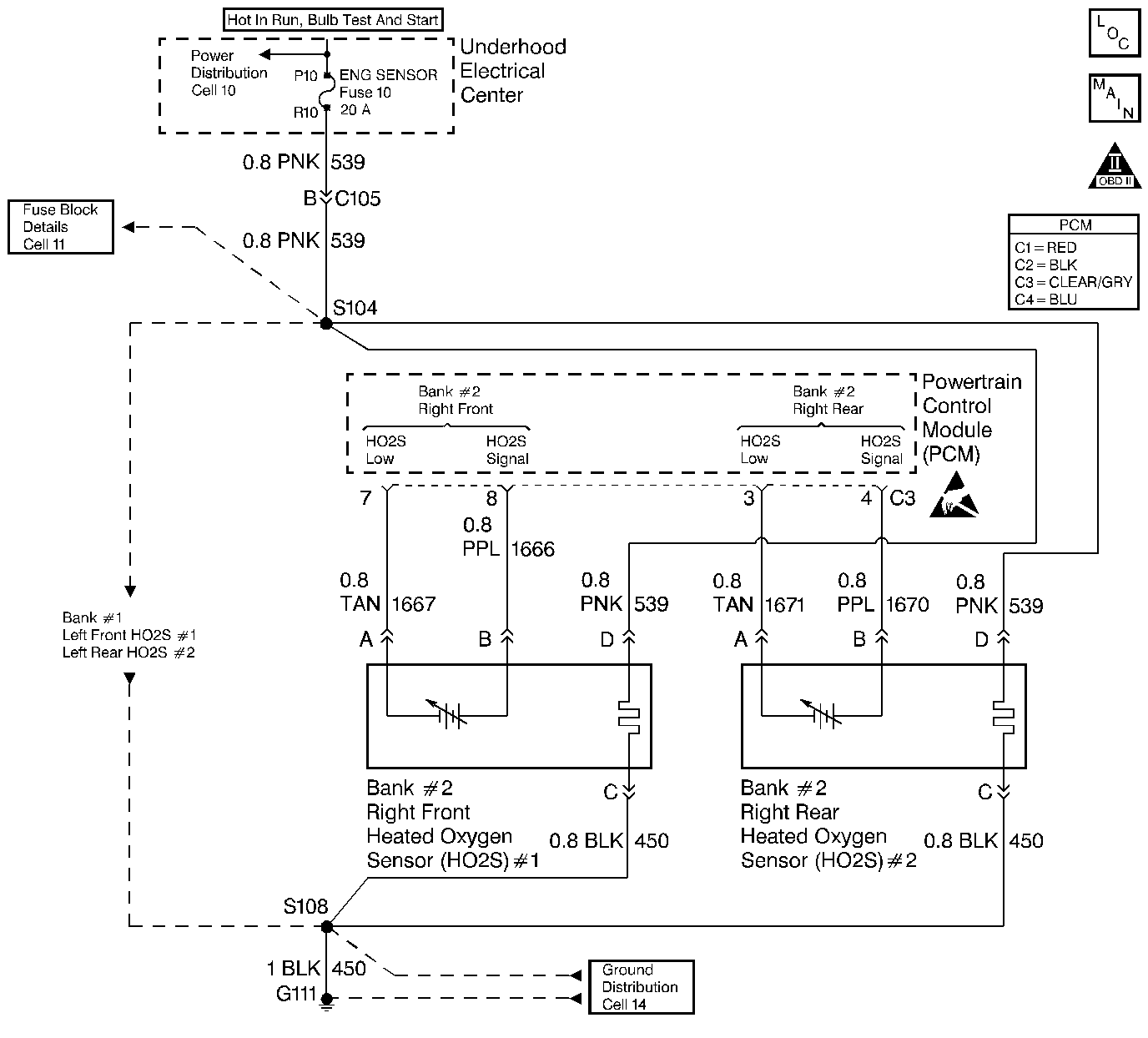
Circuit Description
In order to maintain a reasonably low emissions of Hydrocarbons (HC), Carbon Monoxide (CO), and Oxides of Nitrogen (NOx), a three-way catalytic converter is used. The catalyst within the converter promotes a chemical reaction which oxidizes the HC and CO present in the exhaust gas. This reaction converts them into harmless water vapor and Carbon Dioxide. The catalyst also reduces NOx, converting it to Nitrogen. The PCM has the capability to monitor this process using Bank 2 HO2S #2. Bank 2 HO2S #2, located in the exhaust stream past the three-way catalytic converter, produces an output signal which indicates the oxygen storage capacity of the catalyst. This determines the catalysts ability to convert exhaust emissions effectively. If the catalyst is functioning correctly, the Bank 2 HO2S #2 signal will be far less active than that produced by Bank 2 HO2S #1. If a problem exists which causes the PCM to detect excessive Bank 2 HO2S #2 activity outside of an acceptable range for an extended period of time, the PCM will set DTC P0430. This indicates that the three-way catalytic converters oxygen storage capacity is below a threshold considered acceptable.
Conditions for Setting the DTC
| • | No MAF, MAP, ECT, Left Bank HO2S, Misfire, Left Bank Fuel Trim, Injector, VSS, IAC, Engine coolant fan(s), Transmission DTCs set. |
| • | Engine operating. |
| • | Engine coolant temperature greater than 51°C (124°F). |
| • | Vehicle speed is between 32 km/h (20 mph) and 121 km/h (75 mph). |
| • | Throttle angle greater than 2%. |
| • | Engine speed less than 3500 RPM. |
| • | MAP between 25 kPa and 80 kPa. |
| • | Air flow is between 15 gm/s and 100 gm/s. |
| • | Closed loop fuel control enabled. |
| • | The PCM determines oxygen storage capability of the catalytic converter has degraded below a calibrated threshold. |
Action Taken When the DTC Sets
| • | The PCM will illuminate the Malfunction Indicator Lamp (MIL) on the second consecutive drive trip that the diagnostic runs and fails. |
| • | The PCM will record operating conditions at the time the diagnostic fails. The first time the diagnostic fails, this information will be stored in Failure Records. If the diagnostic reports a failure on the second consecutive drive trip, the operating conditions at the time of failure will be written to Freeze Frame and the Failure record will be updated. |
Conditions for Clearing the MIL/DTC
| • | The PCM will turn the MIL OFF after three consecutive drive trips that the diagnostic runs and does not fail. |
| • | A last test failed (Current DTC) will clear when the diagnostic runs and does not fail. |
| • | A History DTC will clear after forty consecutive warm-up cycles, if no failures are reported by this or any other emission related diagnostic. |
| • | PCM battery voltage is interrupted. |
| • | Using a Scan tool. |
Test Description
Number(s) below refer to step numbers on the diagnostic table.
Step | Action | Value(s) | Yes | No | ||||||||||
|---|---|---|---|---|---|---|---|---|---|---|---|---|---|---|
1 | Was the Powertrain On-Board Diagnostic (OBD) System Check performed? | -- | ||||||||||||
2 | Are any other DTCs set? | -- | Go to the applicable DTC table | |||||||||||
3 | Check for the following conditions:
Was a problem found and corrected? | -- | ||||||||||||
Replace the Catalytic Converter. Is the action complete? | -- | -- | ||||||||||||
5 |
Does the scan tool indicate that this test ran and passed? | -- | ||||||||||||
6 | Using the scan tool, select Capture Info, Review Info. Are any DTCs displayed that have not been diagnosed? | -- | Go to the applicable DTC table | System OK |
